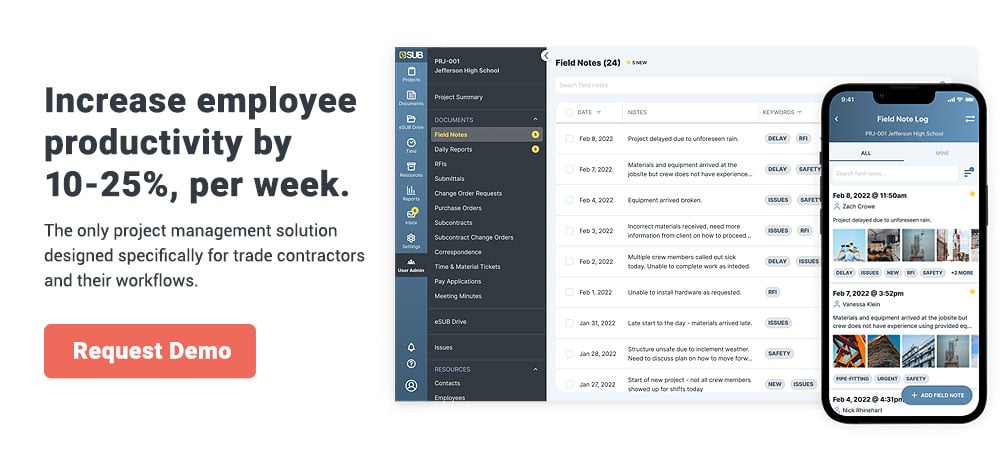Top Construction Trends to Watch for in 2022
Table of Contents
Top Construction Trends to Watch for in 2022
It’s official; 2022 is in full swing.
You may be aware of what 2022 means for you, but what does it hold for the construction industry? Here are some construction industry trends to watch for this year.
Use of collaboration tools
Going into the new year, more collaboration tools will be used to create collaborative project development. These tools include mobile technology, integrated project management tools, BIM design, and virtual/augmented reality.

Mobile technology will continue to grow and will allow the workers on the field and the people in the back office to be in constant communication; this will lead to a greater transparency across parties, and more informed decision making.
To take it a step further, integrated project solutions will become a necessity. These project management tools allow every member of a company to use one software solution for all of their project management activities. This enables every member of the team will be able to open the same application and work off the same information as everyone else, in real-time. Leveraging mobile tech means less miscommunication from inconsistent or lagged information sharing.
On top of this, BIM technology will allow the construction team to make a visual representation of the project, which they can send to all stakeholders before construction begins. BIM gives everyone a chance to voice his or her opinions in a way that will not slow down construction or incur extra costs.
Similarly, virtual and augmented reality allows stakeholders to catch costly mistakes before they occur by being able to visualize how something will work without trial and error. VR/AR will also help communicate field conditions to people who are not physically present on site. The new technology will improve safety by being able to communicate possibly dangerous situations without subjecting the person to the dangerous environment. VR/AR will also aid in safety training for new employees, which will become critical as stricter safety regulations are implemented. The construction industry has so far only dabbled in the use of VR/AR to aid in construction practices, but as cheaper and higher quality options come to market, it is expected to take off rapidly.

Labor shortage
The lack of qualified workers in the construction industry has proven to be an issue in the past and is expected to continue throughout 2017. Between 2006 and 2011, 40% of construction jobs were lost due to the recession, and ever since then, the industry has struggled to get these skilled laborers back. Each year, the construction industry hires fewer workers, with no fast growth predicted. As the current construction workforce ages and less young people are entering the industry due to a lack of emphasis on learning a trade, the industry is trying to find new ways to gain qualified workers. The problem with the worker shortage is its impact on the cost and schedule of projects, which causes contractors not to be able to take on as many projects. With a minimal number of qualified candidates, firms have been forced to become more competitive as they compete for available talent. With less labor available, increased competition is forcing construction firms to increase pay and benefits, which has further hurt the firms’ profitability.

Increased uncertainty
Leading up to this year, questions have been raised about how the new presidential administration will affect the construction industry. Incoming president, Donald Trump, has spoken about increasing infrastructure spending with a proposed $1 trillion plan that would mean a significant number of funded projects for the next ten years. However, many other aspects of the impact of the new administration have been largely unspoken.

Off-site construction
Off-site construction, also known as prefabricated or modular construction, is predicted to gain ground in 2017. This entails constructing parts for a project in a factory rather than on-site, which allows the workers to avoid unpredictable environmental conditions that might put a project behind schedule and increase costs. Modular construction has been around for some time now, but with recent large-scale projects proving its ability to save time and money, it is sure to gain ground in the New Year.
Green practices and sustainability
As the years go on, there is going to be an increasing focus on sustainability. The burden is falling on the construction industry as more and more building owners desire environmentally friendly fixtures and designs. In 2017, the construction industry will make steps toward net-zero buildings, which are buildings that recycle as much energy that is used, so no energy is wasted. These buildings are going to continue to gain ground as the years go on until they become the “norm” of construction.

Conclusion
As 2017 marches on, the construction industry is sure to adopt new technologies and more efficient business practices to combat the continuing challenge of the worker shortage and the uncertainty of a new presidential administration.

Resources:


